If you’re a regular reader, it should come as no surprise to you that here at the Gentleman’s Gazette, we’re big fans of suits; wearing them, collecting them, discussing them–you name it! And while it certainly is fun to grow a suit collection, if you could only have one suit, what should it be? If you’re on the hunt for your first suit or looking to minimize your wardrobe, this guide is for you.
What Are the Challenges When Selecting a Suit?
1. Formality
First things first, then, we need to explore the challenges we face today when it comes to selecting a suit. And the first of these is going to be the challenge of formality. As we’ve previously explored in our posts on whether or not the suit is dying and the supposed end of quality menswear, things overall are getting a lot more casual in the 21st century.

Indeed, it’s becoming increasingly common for more and more places of business to forgo the traditional business suit in lieu of something more casual. Of course, we’ve got you covered there in our comprehensive Business Casual Guide, but the question still remains for the average man: Do I actually need a collection of suits to get me through the workweek?

2. Cost
There’s also the question of cost as, relative to things like polo shirts and jeans, suits can seem quite expensive, especially to modern men who have less experience purchasing them.
3. Endless Options
Finally, there’s no denying that there are a plethora of options for customizing and choosing different details of suits that can be overwhelming to the newcomer.


After taking all of these things into account then, you may be wondering if you even need a suit at all!
Why You Need A Suit
With all those concerns aside, you should have at least one suit in your wardrobe. Throughout any man’s life, there are going to be some events that require a higher level of formality than the typical day might, and this is where having one classic suit is really going to come in handy.
As examples, we could look at weddings, funerals, christenings, or other religious ceremonies (where wearing a suit is a sign of respect), as well as romantic engagements, graduations, or a celebratory meal at a restaurant.
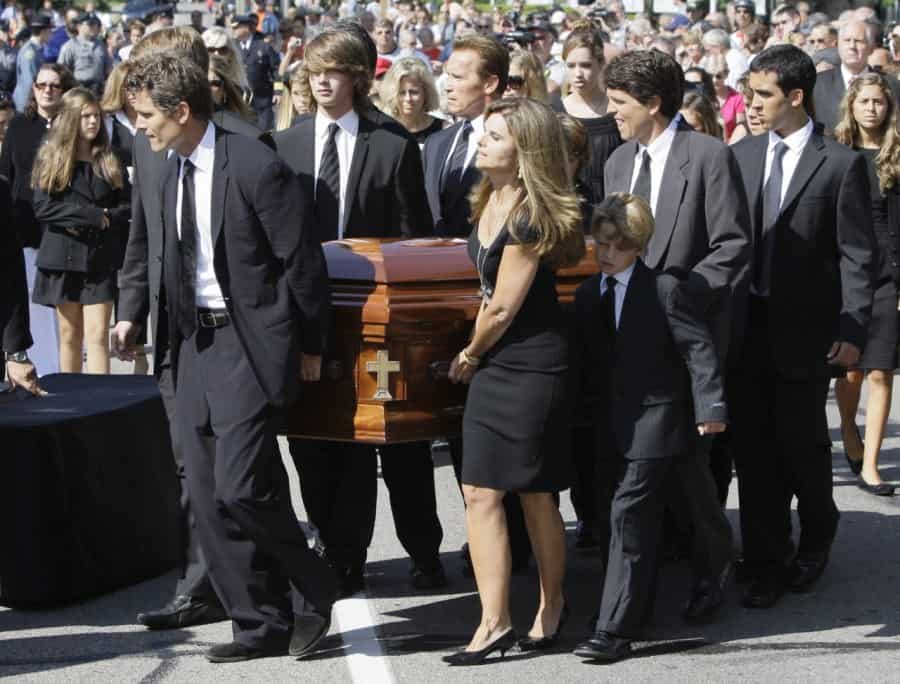
The suit also signifies your own personal investment in the event and the times when a suit is used as a business tool such as job interviews, meetings with clients, or just when you’re looking to further your own career, where your suit will signify your professionalism. Effectively, then, owning the right suit will allow you to be prepared for almost any eventuality.
Choosing The Right Suit: Styling Details
Of course, wearing a suit is all about looking and feeling great, so it’s important to get the styling and construction details correct.
Colors
We’ll begin this section by talking about color, as in many ways, color can be a deciding factor in the overall formality of a suit. So, if you’ve only got one suit and want to ensure that you can wear it to as many different places as possible, we would suggest a dark suit in either charcoal gray or navy blue.
Darker suits are inherently more on the formal end of the spectrum, but they can also be casualized to some degree with the right use of accessories as we discussed more in our Business Casual Accessories Guide.
Conversely, since a lighter-colored suit is harder to be made more formal, you’ll get more mileage and use out of a darker-colored suit. And as we’ve advocated before, don’t make your only suit a black suit unless you want to be mistaken for an undertaker or the missing third Blues Brother.

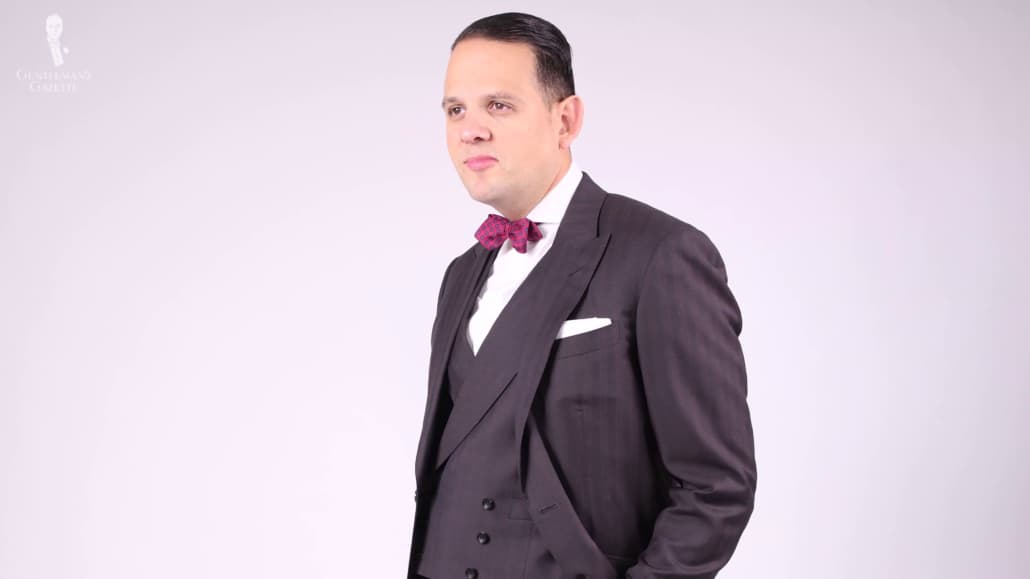
A black suit is too austere and formal for many occasions, it can age poorly as it’s difficult to maintain a true pure black through dry cleaning or other garment maintenance, and, overall, we find black to be the most overrated color in menswear.
When it comes to a charcoal or navy suit, meanwhile, you don’t have to worry about your ensemble looking drab. You can easily add vibrancy and visual interest either through the use of garments like shirts, socks, or shoes and through accessories like ties, pocket squares, boutonnieres, or even shoelaces.
After all, just because we’re discussing only having one suit here, doesn’t mean that we’re also going to limit ourselves to just one tie or pocket square. This point is illustrated in our One Suit, 7 Looks post, where I use one suit and a bevy of Fort Belvedere accessories and other wardrobe elements to create seven different looks for a variety of occasions.
So, as we’ve said, if you only have one suit, you want it to be as versatile as possible.
Jacket Details
Closure
With color out of the way, the next question would be is one breast or two? Ultimately, it’s fairly easy to dress up or dress down a single-breasted suit. But, it can be harder to dress down a double-breasted suit. Although, for a few ideas you, can consult our guide here.
While the double-breasted suit has had peaks in its own popularity, such as the 1930s and 40s, again in the 1980s, and again in the 2010s, around the release of the Kingsman films, the single-breasted suit has always been popular and a good option ever since it was first created.


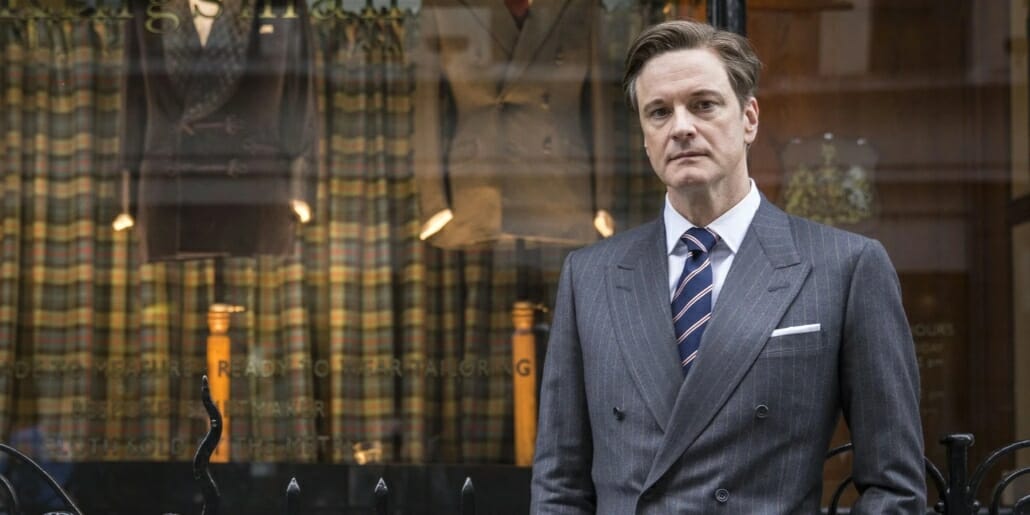
So, unless you’re particularly enamored with the look of a double-breasted suit and think that it will be appropriate for all of your possible occasions, we would recommend going with a single-breasted suit as your one option.
Single-breasted suits are also easy to wear with a matching waistcoat or vest or, for more of an attempt at a spezzato-like style, you could also add a contrasting odd waistcoat for even more outfit options.
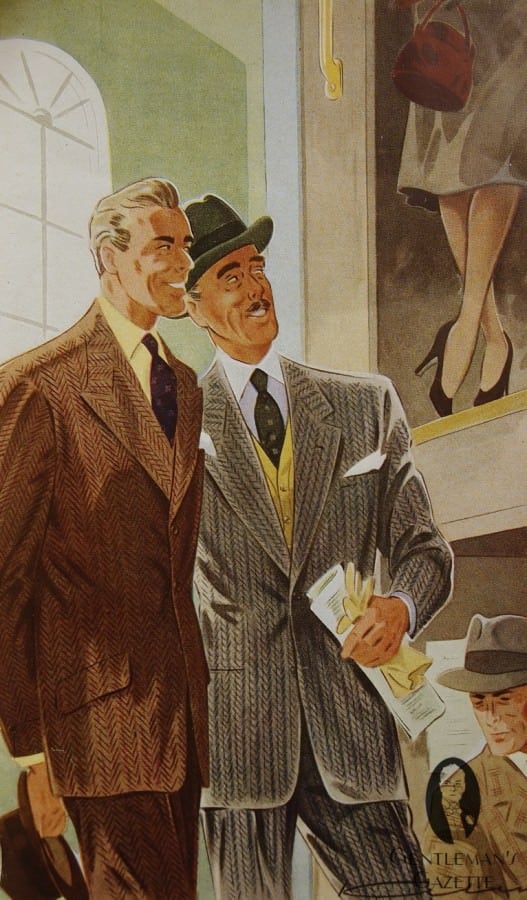
Lapels
Lapels are also going to have considerable influence over the formality of your suit. You’re going to be best served, in general, by notched lapels as they’re the standard for business suits and they’re appropriate across the widest array of different occasions on the formality scale.
When kept within the classic range for width, which is around 4 inches (10 centimeters), they’re not going to command too much attention. You may also want to factor your own stature into this consideration for how wide your lapels should be, but if you stick with the aforementioned general range, you should be fine, as opposed to having lapels that are too narrow or too wide.
That being said, of course, it is your suit. So, if you find that your tastes lean more toward the formal end of the spectrum, tastefully-proportioned peaked lapels could also be an option for you. If you find that they suit your face and your frame and you feel comfortable wearing them, then they can certainly be an option.
Pockets
Exterior Pockets
Let’s start here with the exterior ones. As we discuss in our Complete Guide to Pockets, they’re an often overlooked aspect of suit design that can still have an outsize effect on how a suit looks.
In general, the three main pocket types from most casual to most formal are patch pockets, flap pockets, and jetted pockets. To ensure maximum versatility for your suit, opting for the middle-of-the-road choice with flapped pockets is going to be your best bet most of the time.
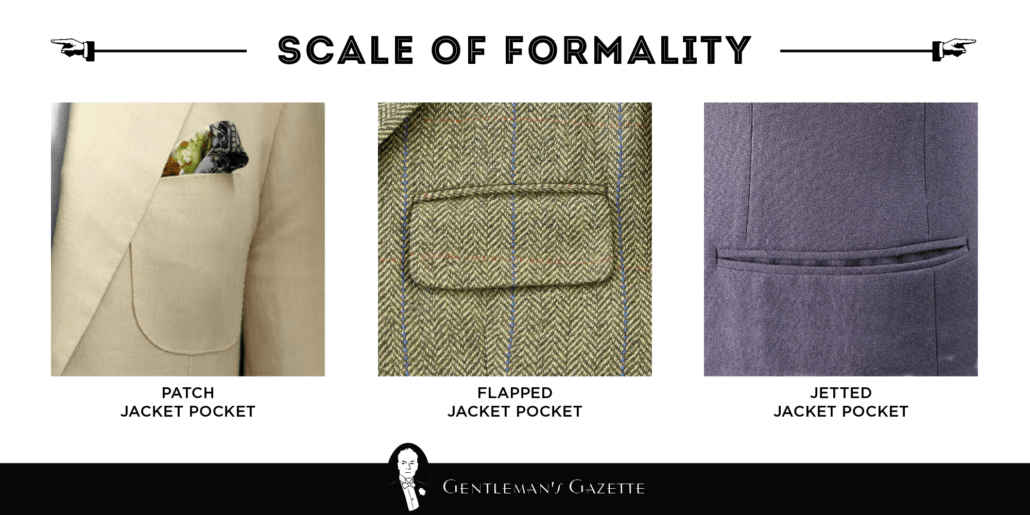
Recently, slanted pockets have become a more popular choice on gentlemen’s suits. And while they have historically been considered a sportier or more fashion-forward look, they look good on slim gentlemen and can provide the illusion of slimness on some more portly gentlemen as well.
A traditional addition to your array of pockets can be the ticket pocket, but keep in mind that it will add a slight note of asymmetry to your jacket.
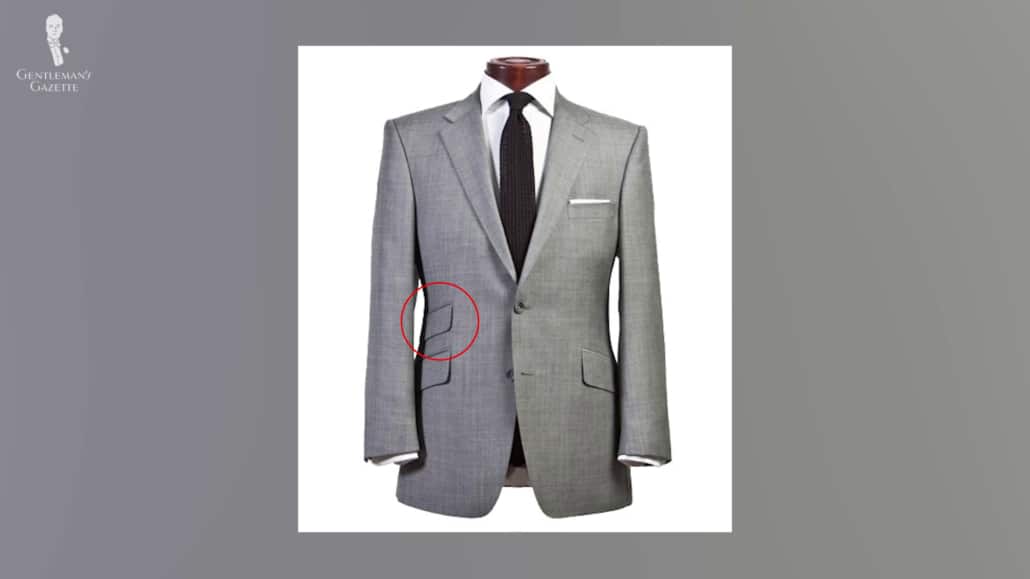
When it comes to selecting a breast pocket, you’ve got the same options as for your hip pockets with another option that has become increasingly popular in recent years, the curved or barchetta pocket. This will add a bit of subtle flair and relaxed touch to the jacket overall. But, again, for maximum versatility, a straight breast pocket is probably the way to go.
Interior Pockets
While exterior pockets are going to have a more significant effect on the overall look of your suit let’s briefly look inside and cover interior pockets as well.
Interior pockets exist primarily for a gentleman’s own personal utility. So, if you’d like to spring for more pockets than the conventional two interior breast pockets, like a fountain pen slip pocket, for instance, this is just a matter of personal choice.
Buttons
We’ve already discussed buttons in our comprehensive guide, but in general, know that buttons in the mother of pearl, horn, or corozo nut could be a good investment.
In terms of both aesthetics and durability, they’re going to add a touch of elegance to your suit and, if cared for well, can actually last longer than conventional plastic buttons.
For your navy or charcoal suit, this will typically mean going with dark blue, dark gray, or dark natural horn buttons. High-contrast buttons can be fun, of course, but they will make an outfit more casual overall, and this will sacrifice a bit of versatility.
So, leave those gold buttons for your blazers, in particular. And for other colorful buttons, save those for when you are growing your collection even further.
More important than the material of the buttons, though, is how they’re arranged. The most common choices for single-breasted suits are going to be two-button, three-roll-two, or three-button styles with one-button jackets gaining popularity at different points in time.
For most situations though, a two-button jacket or three-roll-two, which essentially functions in the same way as a two-button, are going to be your most versatile options. They represent a good middle ground in formality as opposed to the three-button jacket which, with its high buttoning stance, can look overly formal and a bit stuffy.
Three-button jackets also have the tendency to look a bit dated. We have created another guide on how to properly button your garments, where you’ll find more information on this topic.
Meanwhile, when it comes to cuff buttons, the number on your sleeves can vary, but four, the number that was originally championed by English tailors, is the standard now. For a bit of added personality, you could select three or five cuff buttons. But, any more or less than this is going to be distracting.
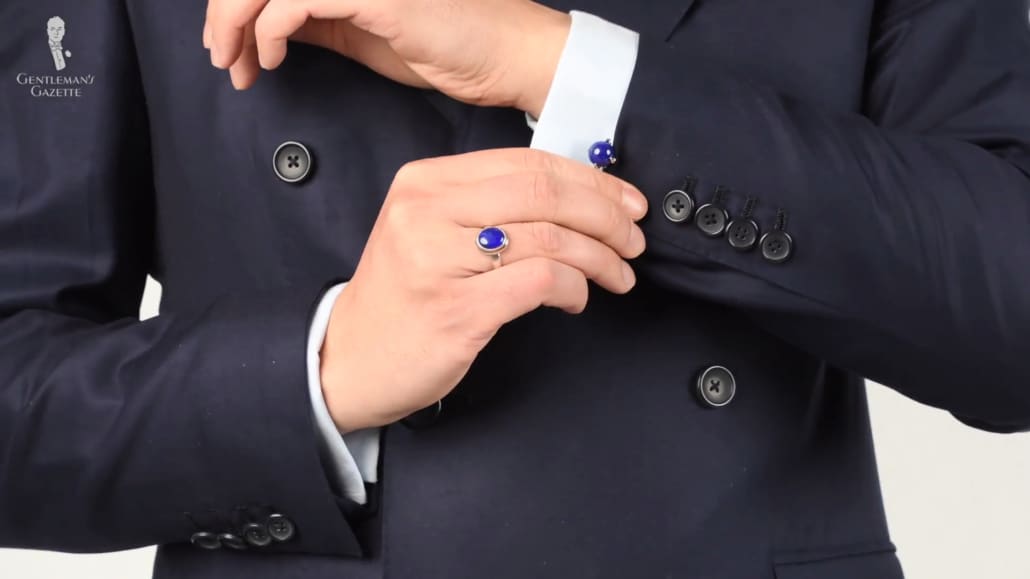
Vents
Before we move on to the trousers of the suit, let’s also briefly cover vents. At the rear of the jacket, you’ve more or less got three options, which would be having no vent, having a single vent, or having a double vent.


Having no vent is the most formal and traditional option, and while it will look best if the suit is truly fitted well to you, it can also look a bit awkward when you’re sitting or if you like to put your hands in your pockets.
Meanwhile, as the single vent has its origins in horseback riding and other casual activities, that casual association still remains. So, again, for your one and only suit, we’d recommend going with the middle-of-the-road option, which, in this case, would be a double vent.
Trouser Details
Pleats (Or No Pleats?)
Your two most important considerations here will be pleats or no pleats, and cuffs or no cuffs. For the most part, these are going to be dictated by comfort, body type, and personal choice.

For instance, most of the trousers in my own wardrobe are currently flat-fronted, which works well with my slim build. Though, I do also like the look of inward-facing pleats and hope to get more trousers featuring them in the future.
Meanwhile, uncuffed trouser hems are going to provide a clean and sleek look. While I don’t currently have any cuffed trousers in my wardrobe, I hope to get more of those at some point as well.


Raphael, on the other hand, finds pleated trousers not only to be comfortable but almost a personal requirement as he has large thighs. And he likes cuffs or, as the Brits would say, turn-ups, on most of his trousers with the exception, of course, of the more formal styles such as Black Tie, White Tie, and Morning Dress.
Rise
For the most classic look, you may want to consider going with high-waisted or high-rise trousers.
Cuffs
All things considered, it’s best to think ahead a little bit when considering your trouser hems. Cuffs are going to help your trouser legs hang a bit better on your frame and they can be removed later if you so choose.
Plain trouser hems are going to look neat and more formal, but it’s impossible to add cuffs to a pair of trousers if you don’t have a fabric reserve. So, when it comes to your one suit, consider the formality level you’d like to have and, so long as you have a good fabric reserve, you can make whatever decision you’d like over time.
And as far as pleats go, they’re going to create more comfortable trousers and they’re going to be hidden by the jacket’s quarters most of the time, but you don’t need to add them if you don’t want them.
Fine Detailing
For many decades in the late 19th and early 20th centuries, fine details like Milanese buttonholes or working cuff buttons sometimes called “surgeon’s cuffs” were hallmarks of a high-quality suit. But, changes in suit manufacturing techniques in recent decades have led to these features becoming far more common even on cheaper, lower-quality suits.


As examples of these more subtle details go then, vertical pockets on your trousers can be useful, especially if you need to discreetly keep things in them as James Bond often needs to do. With trousers, side adjusters are literally going to give you more room over time for potential weight fluctuations.
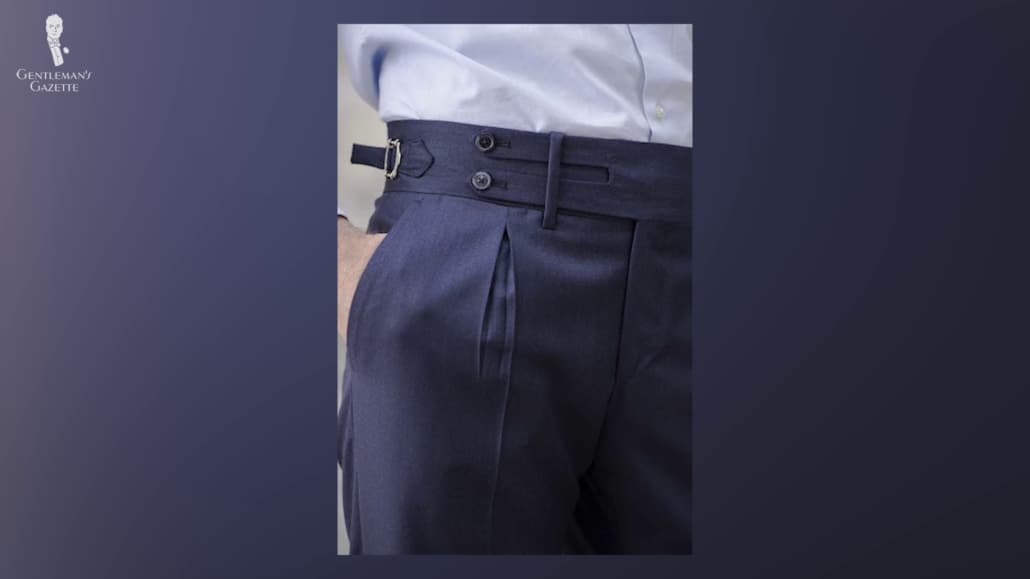

So, when it comes to your suit’s additional details, opt only for those that you truly like and that you can afford, and remember that subtlety is always going to be more elegant than flashiness.
Fit (Most Important Element!)
Regardless of whether you’re looking for just one suit or for several, the most important factor to consider is always going to be fit. We’ve discussed extensively this topic before, but if you’re only going to have one suit in your wardrobe, the fit is, of course, going to be paramount.

So, when it comes to the overall cut of your suit we would recommend avoiding both an exaggeratedly slim-cut, which may be trendy now but will eventually fall out of fashion again just as it did after the mod look of the 1960s waned.

You might also want to avoid an overly loose or billowy suit, which will have the tendency to look dated and won’t do your frame any favors overall.
Instead, focus again on a pleasing, neutral cut that isn’t so narrow that will make it look as though you were squeezed into your suit like a sausage casing, but also not so wide, as to give the effect that you don’t have the pleasing silhouette of a broad shoulder and narrow waistline.
This well-fitted middle-of-the-road suit then will always be in style as it’s going to accentuate your best features while hiding your flaws, but not doing either in an extreme way.

For the majority of us, a suit is typically going to be purchased ready-to-wear or off-the-rack. There’s nothing inherently wrong or bad about this. And, indeed, it is entirely possible to find a good-quality, ready-to-wear suit that covers all of the criteria we’re discussing today.
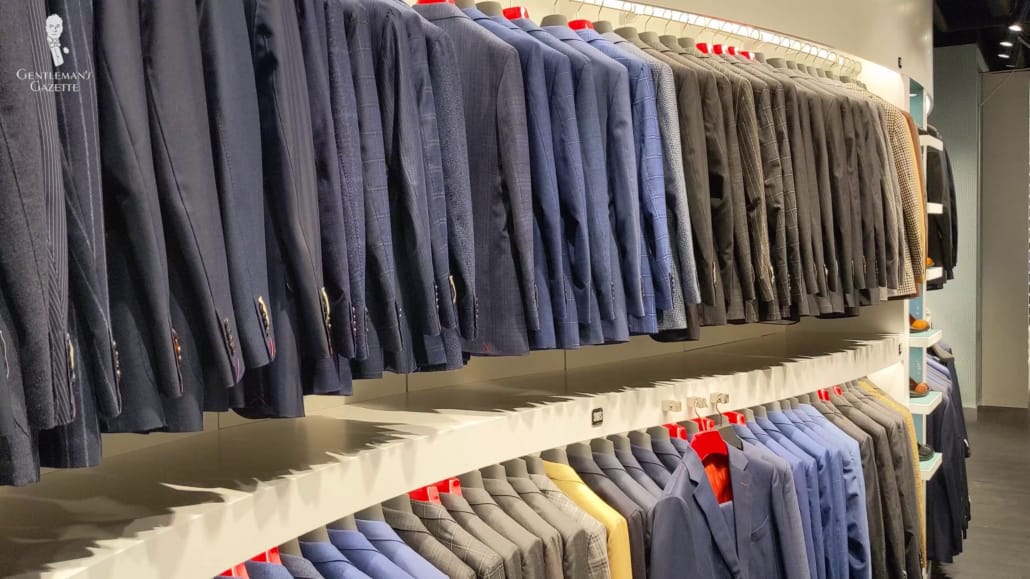
So, with a ready-to-wear suit and a brief trip to the alterations tailor, your overall cost should still come in lower than a high-end bespoke suit, but you’ll have a good fit and most of the proper details we’ve discussed today. On that note, we have a guide about what an alterations tailor can and can’t do.
Fabric
Worsted wool is the gold standard for most business suits and it’s the choice we’d recommend for most men. It’s reasonably hard-wearing, insulating when it’s cold, and breathable when it’s hot, which makes it a good choice for a year-round or all-season suit.
For comfort, you might be tempted to go with a lighter-weight fabric because you’d think it would be cooler, but especially lightweight fabrics don’t drape well on your frame and also tend to wrinkle easily. You’re better off taking other steps to stay cool while looking cool.
As an example, if you live in a warmer climate, you might consider getting a suit that is half-lined. Of course, if you live in an extremely hot or tropical area, you may want to consider going with linen or some of the other hot weather suit fabrics.


If you live in an extremely cold climate, you could go with a heavyweight wool flannel, and consider layering up with overcoats. But, for most people, suits in things like seersucker or tweed aren’t going to have as much versatility as a standard worsted wool suit will.
Construction
One benefit of limiting yourself to a single suit is that it can be a true investment piece. All the money you might spend on several suits over multiple years can instead be put into one high-quality suit that should last you decades.
If cared for well, this suit should be able to be worn for a variety of occasions and will establish a particularly good cost-per-wear. Allegations that suits are inherently uncomfortable can put many men off of buying and wearing them, but these allegations usually stem from men wearing cheaper suits in the past, which do have a greater likelihood of being uncomfortable.
So, for your one suit, make sure that you invest in quality when it comes to workmanship and materials, at the highest price point that you can reasonably afford.

One of the biggest areas that will aid in a suit’s overall comfort, then, is the construction of the jacket. Increasingly often these days, even ready-to-wear suits can be found with a canvassed interlining, which will mold to your body over time and be more comfortable in the long run.



Raphael goes into more detail about the differences between a $100 vs a $1,000 suit in another guide, but, in summary, a lower quality suit typically has these qualities you’re better off avoiding:
- Made with inferior fabrics like polyester, nylon, or other artificial fibers that aren’t breathable, are too stiff to be comfortable, and often look shiny and cheap.
- Has a glued interlining that will make you look stuffy and will eventually come loose, poor workmanship that will lead to loose threads, easy tears, and uncomfortable fits.
- Has unattractive cuts with ugly styling that is either too boxy or too sharp, looking either dated or trendy, and with poor assembly like deep cut armholes that are going to restrict your movement.
How Much Should You Spend On Your One Suit?
Ultimately, this is, of course, going to come down to your own personal financial situation, but remember that investing upfront in quality can often pay dividends for the future.
On the other hand, though, it should also be remembered that a well-made suit doesn’t always have to be expensive as you can pursue the vintage route as well. For tips and tricks on effective vintage shopping, our comprehensive on that subject has you covered.
And if you find that online shopping is more a suitable option for you these days, we’ve also got you covered on that front with this post.

Summary and Outfit Rundown
To summarize the points we’ve made here today, let’s take a look at the following example outfit.
The suit is charcoal gray with just the subtlest hint of pattern and texture to its worsted wool weave and it’s also single-breasted with two buttons, a double vent, and notched lapels. It’s got flap pockets and four cuff buttons on each sleeve, and the trousers are flat fronted and have no cuffs.



In its original configuration, the suit is three pieces as it does also have a matching waistcoat, though, it can, of course, be worn in the simpler two-piece style.
I’m wearing a plain white shirt with a typical point collar and barrel cuffs, so no cufflinks today, and my shoes are classic black cap-toed Oxfords.


Adding hints of color are my accessories from Fort Belvedere. My socks, which are in charcoal gray to harmonize with the suit, but do also feature subtle clock patterns in red and white. My pocket square is in plain white linen with a contrasting red x-stitch and my mini carnation boutonniere is also in white but with magenta accents. Finally, my tie is in red madder silk with a geometric micro-pattern in buff.



While there are slightly varying shades of red across the different accessories in my outfit, they are all grounded by the charcoal gray of the suit and work harmoniously overall.
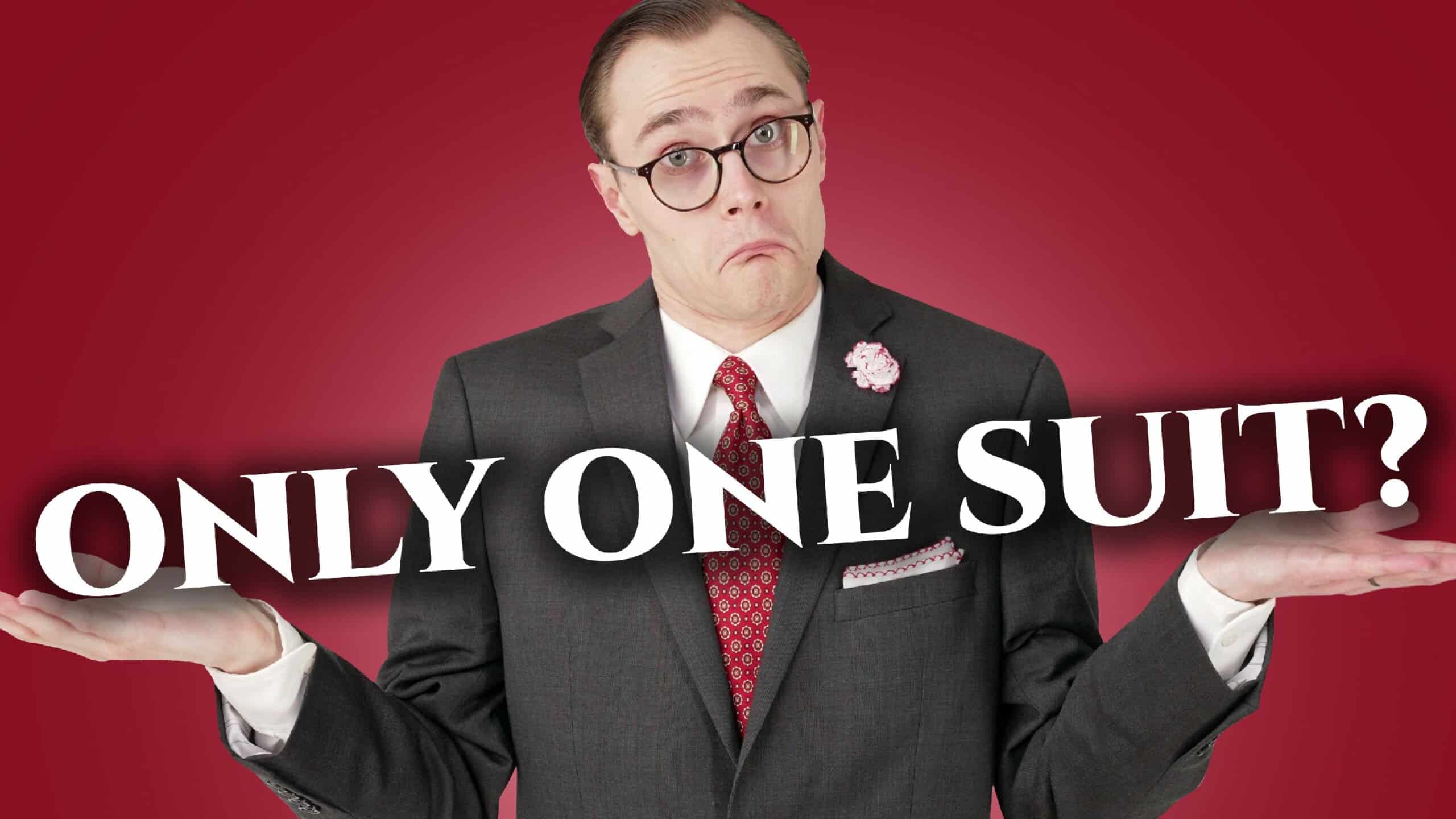




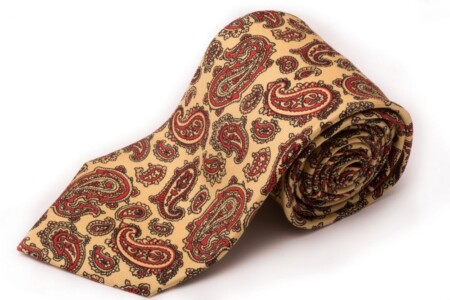
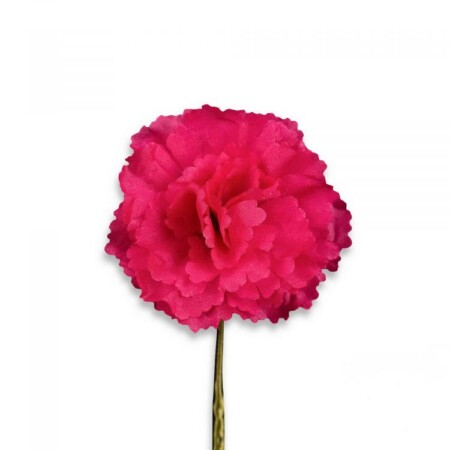

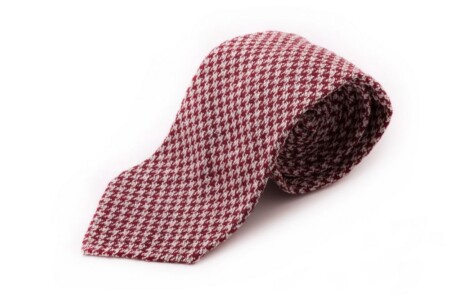
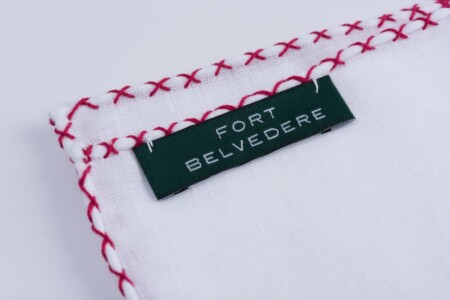

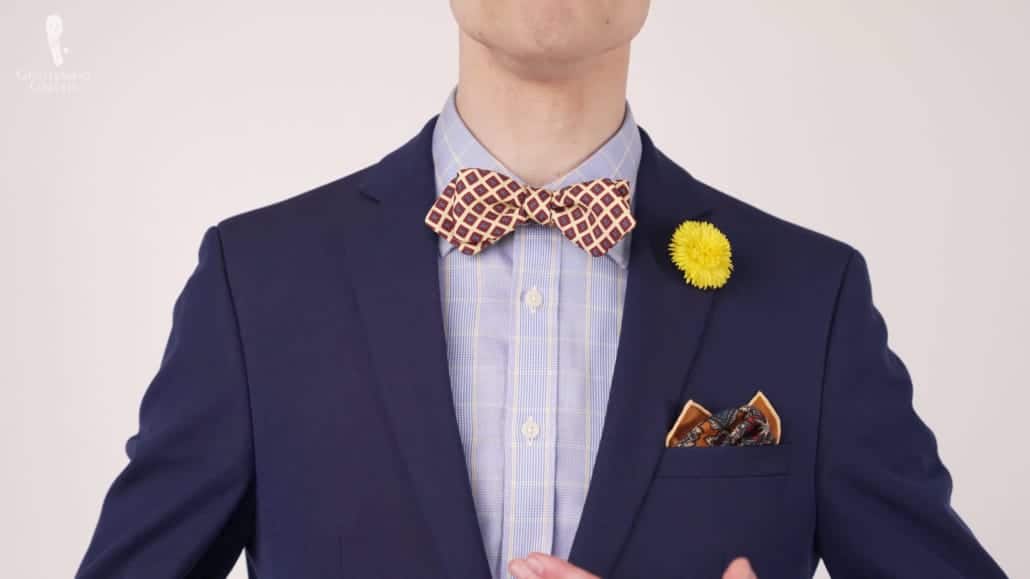
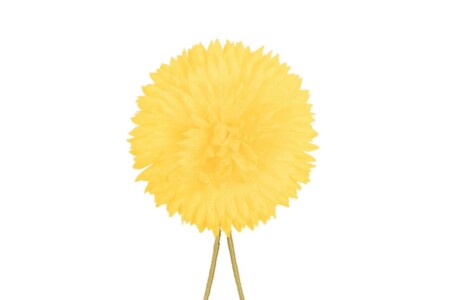
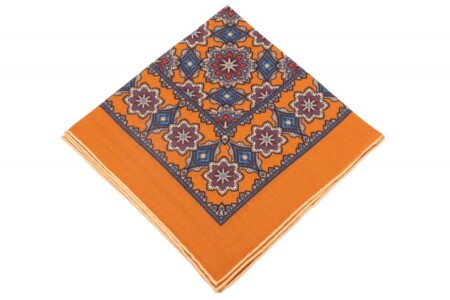
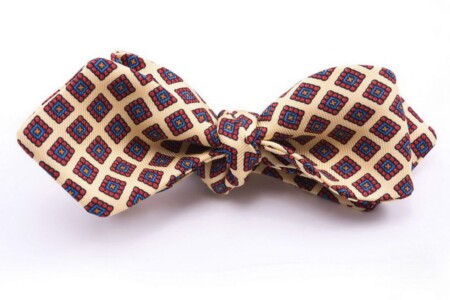
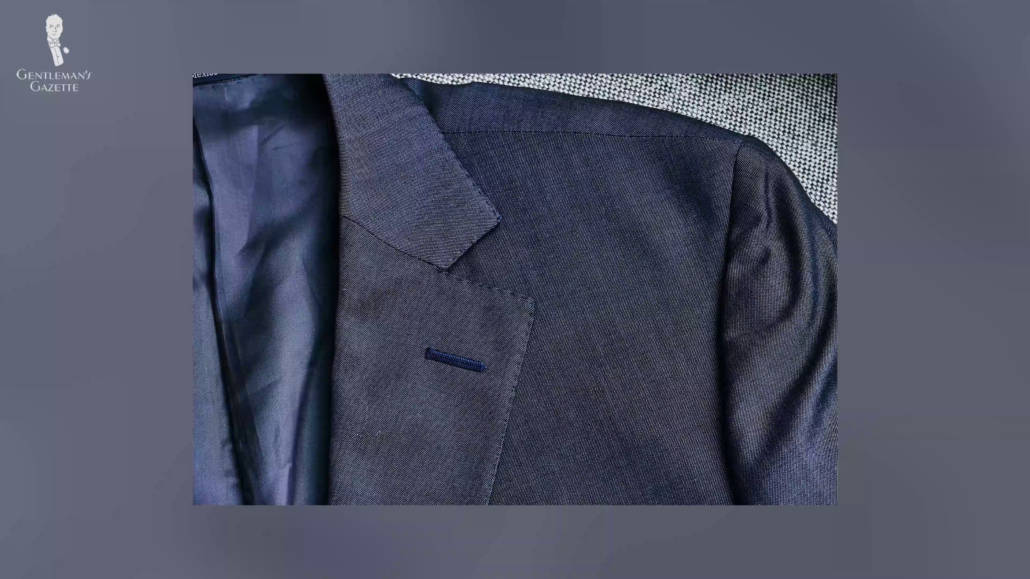












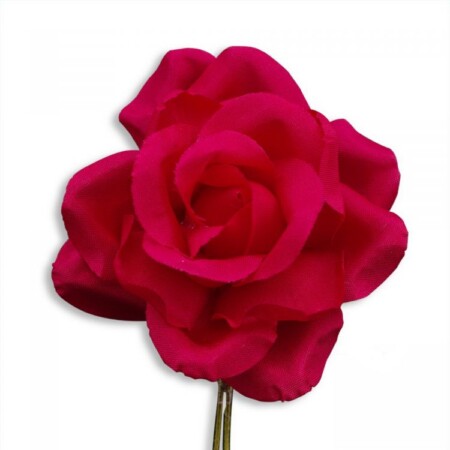
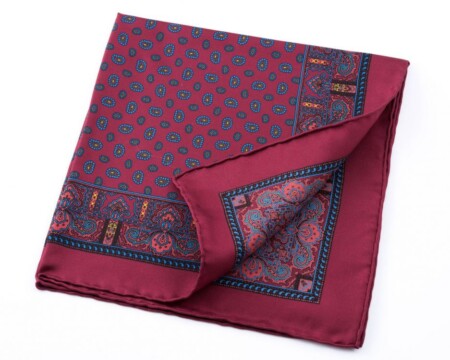
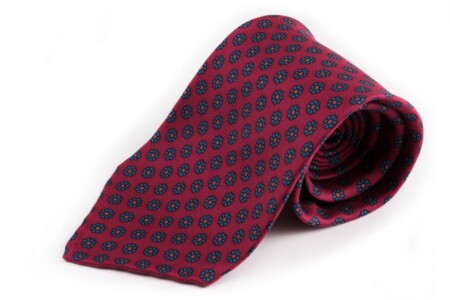


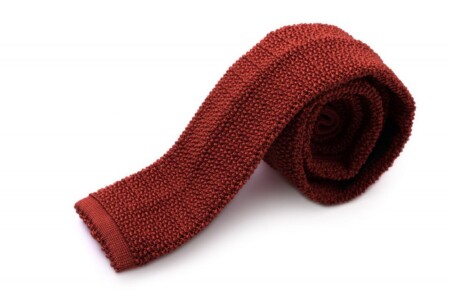
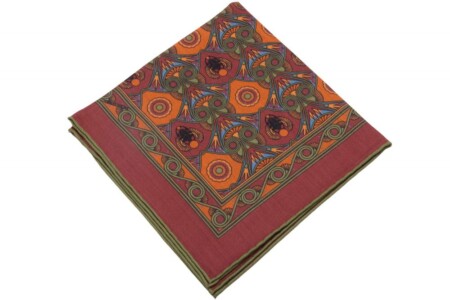

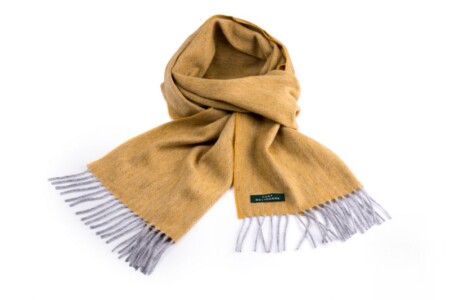
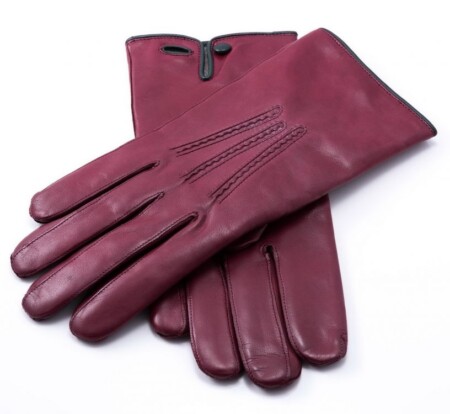


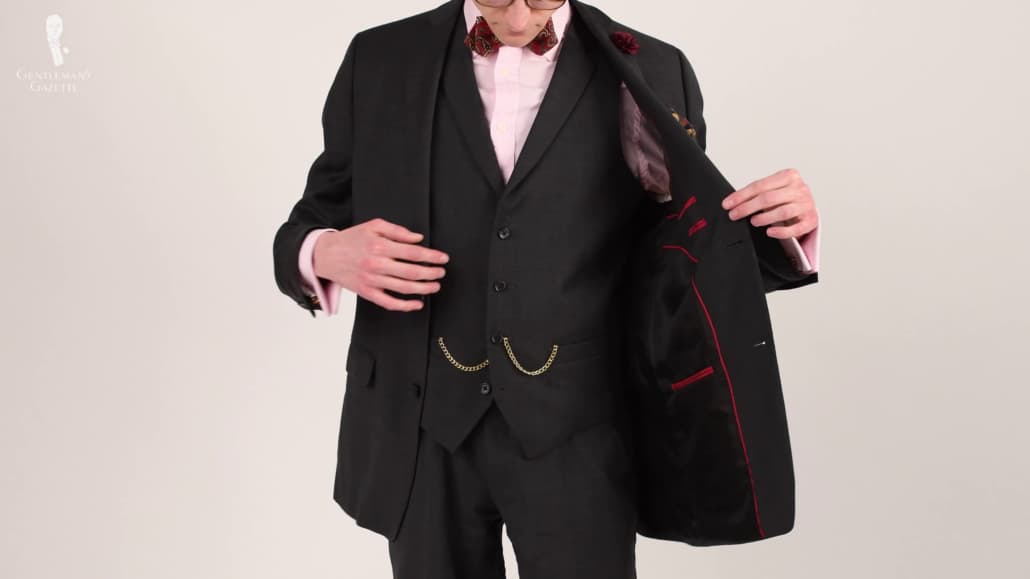
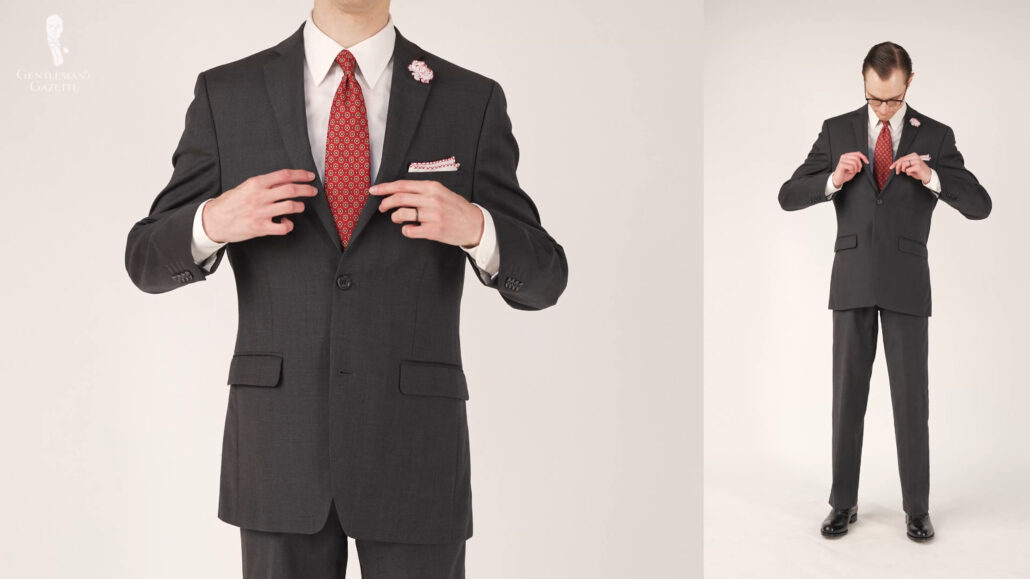
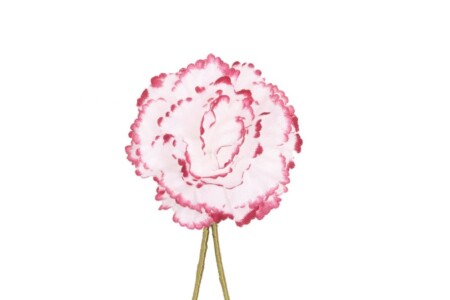
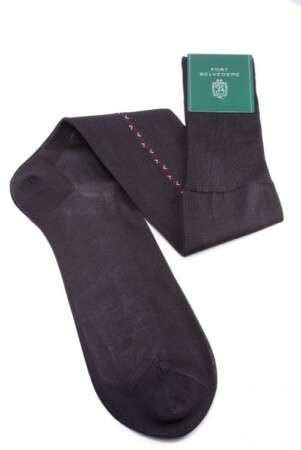
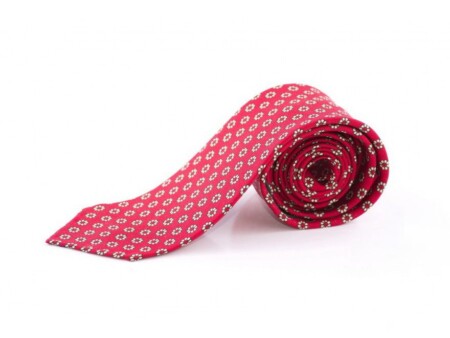
Still, I do not understand why having no vent should be the most formal choice. My point of reference for formal elegance would be the morning coat, which has one vent!
Plus, doesn’t allow for a better fit to have one or to vents? I’m not convinced that no vent is elegant enough for formal occasions – it rather reminds me of rather casual or practical clothing.
Sorry for the rant, but I really would like to get more background concerning that point.
Epimetheus, you are absolutely correct that both a morning coat and an evening tailcoat feature a single vent in the tails, yet are the most formal jacket styles for their particular occasions. They feature a vent due to the length of the tails in question, as if the tails were closed, the jacket wouldn’t move well with the wearer and would be uncomfortable whilst sitting.
This is equally true of frock coats, which were the precursor to the lounge suit jacket. They too featured vents (sometimes several), so that the jacket could move with the wearer, and didn’t become a hindrance throughout the day. When the shorter jackets of the lounge suit rose in popularity, the vent gradually disappeared, as the jacket wasn’t long enough to become wrapped around the legs. It also created a clean, formal silhouette as it followed the contours of the body from shoulder to hips without breaking at any point.
Naturally, the practicality of the vent remained for sporting uses, primarily assisting wearers to remain comfortable whilst on horseback. This is why a single vent on anything other than a morning or evening tailcoat is considered the most casual, due to its associations with traditional sporting/country wear.
Although the no-vent look is still considered most formal, especially for black-tie ensembles, the figure-hugging construction can be restrictive when searching for items in trouser pockets, and creases can form when sitting in a jacket without vents. Thus, double vented jackets are the modern-day standard for the majority of suiting, as they encompass the practicality of a greater range of movement (including access to pockets), whilst maintaining a flattering silhouette without the reference to sporting clothing.
I hope this has been helpful, check out the black-tie guide to learn more about the finer points of vent etiquette!